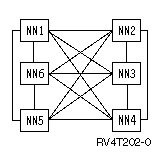The number of control program-to-control program (CP-CP) sessions that are configured for each network node (NN) has a direct impact on the performance of a network. Network control information such as topology updates and location searches flow over CP-CP sessions. A consequence of too many CP-CP sessions is that information is sent out to more nodes and the same node multiple times. This increases the network processing that is done. In a mesh-connected network, every NN has a CP-CP session with every other NN, increasing the number of CP sessions in this network. The number of CP-CP sessions in the network should be kept to a minimum while still providing necessary connectivity.

A CP-CP spanning tree is a term that is used to describe the contiguous path of CP-CP sessions between nodes throughout the network. CP-CP sessions carry necessary control information and are required between NNs in order to participate in the APPN network. Careful analysis to determine the minimal set of links, that support CP-CP sessions, is important. Once these links are identified, it is recommended that back-up links providing alternate CP-CP sessions are added to the network. These backup links ensure availability of the CP-CP spanning tree and are needed if the critical links fail.
APPN architecture does not allow two adjacent APPN NNs to connect and establish CP-CP sessions when they do not share the same network identifier (NETID). Border nodes overcome this restriction. Border nodes enable NNs with different NETIDs to connect and allow session establishment between logical units (LU) in different NETID subnetworks. Border nodes prevent topology information from flowing across different NETID subnetworks. Use border nodes to subdivide a large APPN network into smaller and more manageable subnetworks. iSeries provides this border node capability for only adjacent networks.
The amount of processing is reduced when the iSeries is an end node or LEN node, as opposed to an NN for the following reasons:
- All network topology, and directory search information flows to every attached network node.
- End nodes and LEN nodes do not receive most of these information flows.
The network nodes (NN) perform route calculation for themselves and other ENs and LEN nodes. (This function flows from the EN or LEN node to the NN.)
In addition, topology information about ENs and LEN nodes does not flow through the network. NN topology does flow to the entire network that causes the other network nodes to process information about every other network node.
Branch Extender is an extension to the APPN network architecture. It appears as a network node (NN) to the Local Area Network (LAN), and as an end node (EN) to the Wide Area Network (WAN). This reduces topology flows about resources in the LAN from being disconnected from the WAN. The only topology flows necessary are for network management that identify the types of links.
For more information about setting up Branch Extender, see the page Changing network attributes.